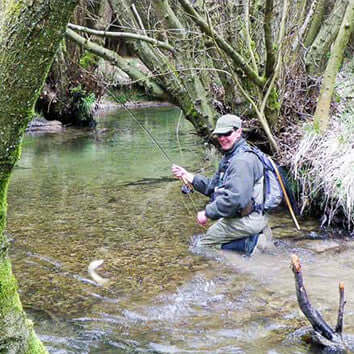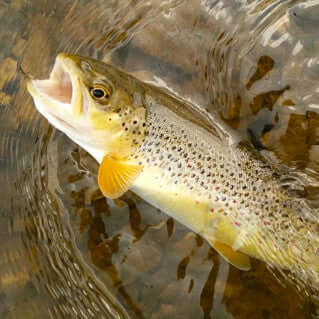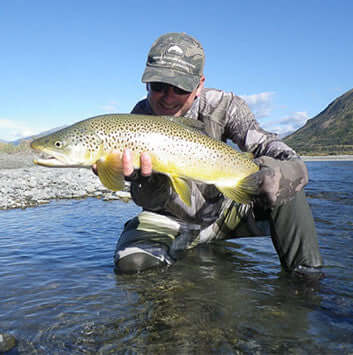Sunray Micro Thin lines, particularly the Jeremy Lucas lines with their long (18’) front taper down to an incredibly fine 0.55mm diameter & the Micro Nymph lines, provide unbelievably delicate presentation but they are useless if the angler using them has already scared every fish within casting distance.

The author using camouflage & cover to stalk fish in gin-clear water (photo by Steve Donohue).
A stealthy approach is vital
...when fishing for wild fish, particularly those in waters that are not heavily fished. The only exceptions to this are:
• Stock fish straight from the fish farm that have learned to associate people with food. These tame fish will actually come to see if a clumsy angler & splashy casting means that their next feed of pellets has arrived. Personally I am not interested in catching stupid stockies but those who are can ignore this blog.
• Fish that see lots of anglers are also hard to spook. I well remember fishing an easily accessed spot on Soda Butte Creek in Yellowstone National Park, Wyoming.
A couple of guides & half a dozen clients fished through a pool before I fished it, but I need not have worried. The Cutthroat trout were so used to anglers that the shoal would separate to let you wade upstream & then start feeding immediately that you had passed. However, they were incredibly well educated & would reject anything but a perfectly dead drifted fly.
Rising fish even turned away when a natural fly was pushed slightly off course by a puff of wind. If the Soda Butte fish had stopped feeding when anglers were about they’d have died from starvation.

Stuart Crofts keeping a low profile
• Similarly, fish next to popular public footpaths can be very tolerant of the angler’s presence. Generally, however, it is important to take the
Greatest of care when approaching our quarry.
Next time you see a heron just watch how it behaves & replicate it. Herons hunt at very short range & there is no doubting the fact that fishing at short range can be far more effective than fishing at long distances for the following reasons:
• It is easier to cast accurately to a visibly feeding fish or to a probable fish lie at close range.
• It is easier to avoid drag with less line on the water (ideally all the line held off the water).
• It is easier to facilitate any required line control such as mends or subtle fly manipulations to induce a take with a short line.
• It is easier to see the take & to set a hook at close range. So what exactly can we do to avoid scaring our intended quarry, particularly when fishing at close range?
• First & foremost I’d say that very slow movement & the avoidance of any unnecessary movements are probably the most important aspect of a stealthy approach whatever the situation. Fish are unable to focus clearly at distance but their vision is unbelievably sensitive to movement, rather similar to our human peripheral vision but even more so. Furthermore, clumsy movements whilst wading will send ripples through the water that will be sensed by the fish’s pressure receptors along their lateral line (line of dots along the fish’s flank) warning them of the presence of predators; this is particularly important in areas where the water is slow flowing or still as there is no turbulence to mask the angler’s movements.

Stuart Crofts took several minutes crawling into a position to cast to this fish.
If you do spook the fish it is often worth standing totally still for a while as grayling in particular will soon settle down after minor disturbances.
• Wearing subdued/camouflaged clothing helps considerably. I often wear full combat camo gear.
• Make full use of any cover. This may be by hiding behind cover such as bankside reeds or rocks, but equally, if these aren’t available, as when wading, we can use a suitable background such as trees or a high bank to avoid being silhouetted against the sky.

Stephen Donohue kneeling behind cover on Foston Beck Chalk Stream, East Yorkshire
If this is unavoidable as when boat fishing a blue or pale shirt/jacket & hat may be more appropriate than full army camo gear (the folks who fish for bonefish on the subtropical & tropical flats of Florida etc. love their blue shirts!)
• Keep a low profile so you stay below the fish’s field of vision into the outside world. My knee pads get heavy use in shallow waters when wading & when bank fishing.
• Avoid false casting like the plague. On a recent trip to one of the gin-clear chalk streams of Wiltshire I watched a friend spook virtually every fish that he was targeting because he insisted on false casting.

Keeping a low profile can reduce how easily the angler is seen in the fish’s window to the outside world, particularly if the fish is in shallow water or on the fin near to the surface. This diagram shows how light rays travel in water, light beyond a 97 degree cone being internally reflected such that the fish no longer sees the above water world.
• Avoid garish coloured fly lines. I prefer white, olive or grey.
• When wading avoid as far as possible any noise from the crunching of studded waders or metal ended wading staffs. I must confess to using studs in my rubber soled wading boots for added security, but I like to have a rubber cap on the end of my wading staff. Only after these precautions have been taken can light, delicate presentation, lines, long leaders & good casting be of any value.
































